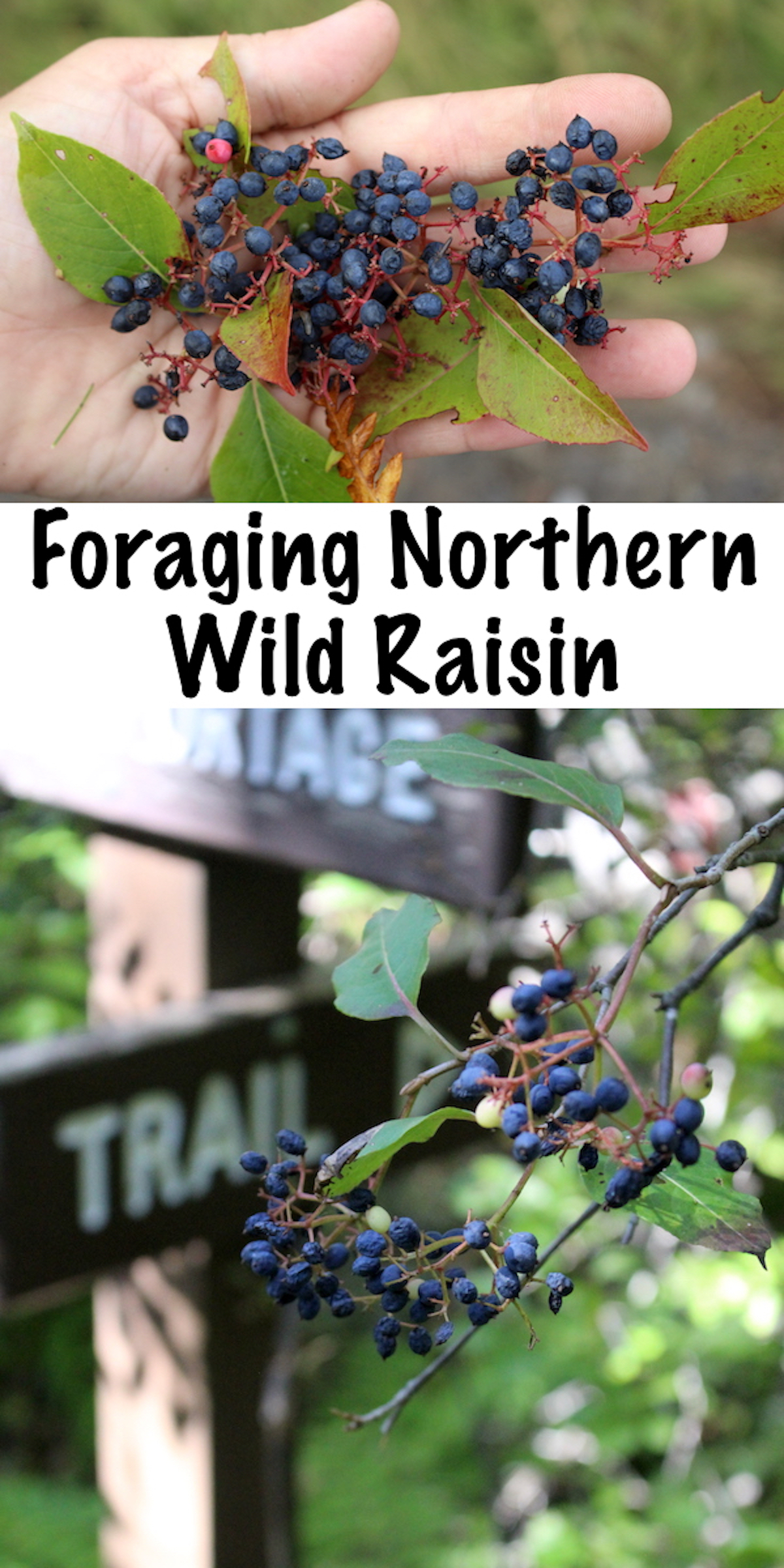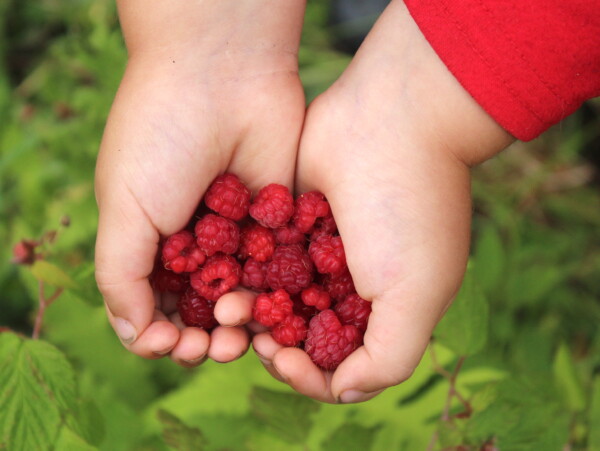Affiliate disclosure: This post may contain affiliate links. Please see our Privacy Policy.
Northern Wild Raisin (Viburnum cassinoides or V. Nudum) is a tasty wild edible viburnum species that are common in the north woods, especially around ponds, ditches, and other consistently wet areas. The fruit taste remarkably like raisins, but with a single large seed inside. They’re easy to identify and make a delicious trailside snack.
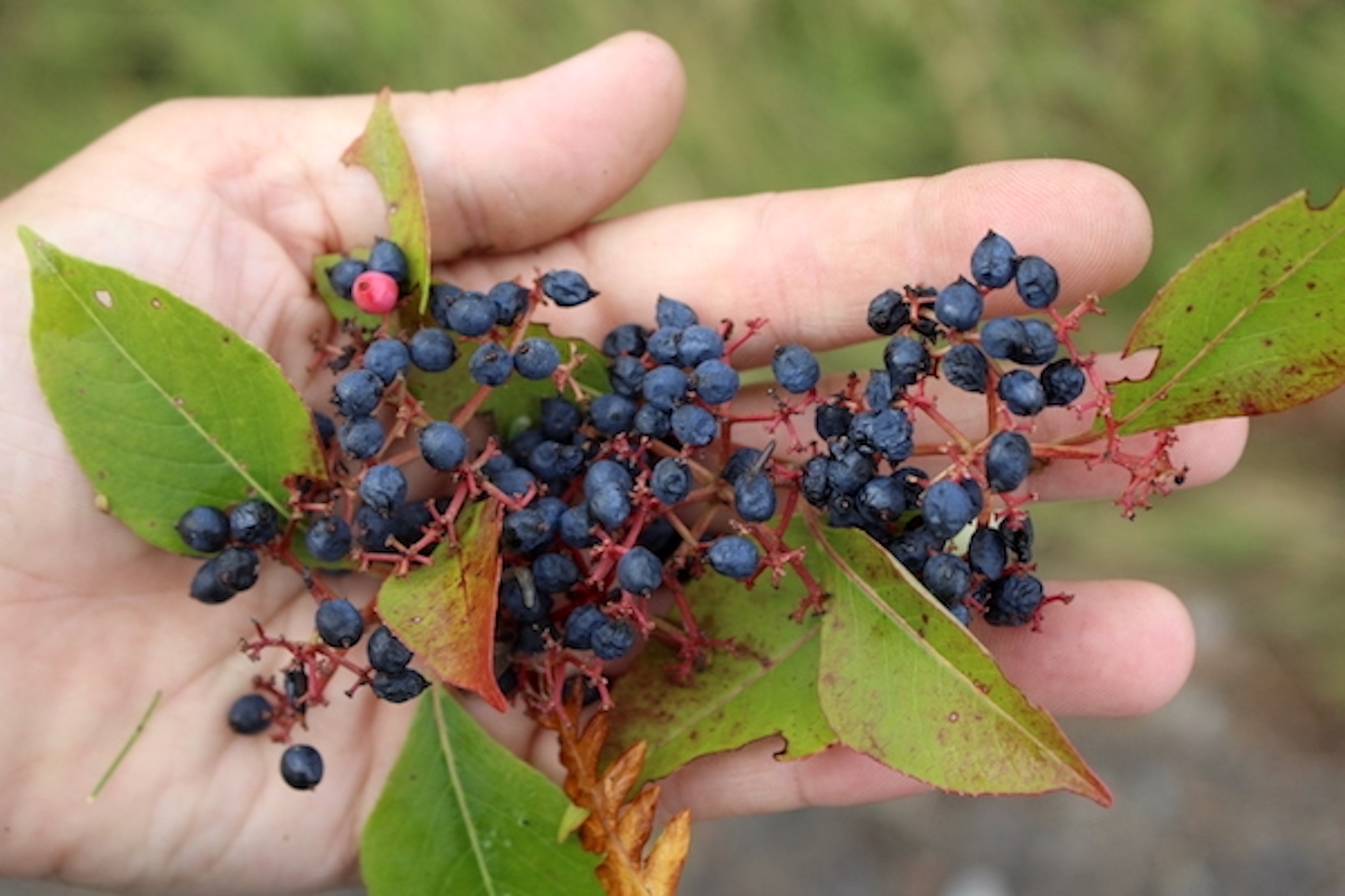
Though Northern Wild Raisin is sometimes called witherrod, I like to call it how it tastes. The name witherrod refers to the wood, and in old english, translates to “Flexible stem.” Back in the day the wood was a valuable and useful comodity for basket making, fish traps, arrows and other places where you’d want resilient thin stems.
These days, it’s less valued as a building material, and foragers just love it as a fun trailside snack. Landscapers love growing wild raisin for its profusion of bright blooms in the spring and tolerance to poor wet soils, and you’ll sometimes see it used in drainage ditches around parking structures and runoff areas.
Be careful where you harvest, and ideally, keep it as a trailside snack while out backwoods hiking (rather than near potentially polluted areas).
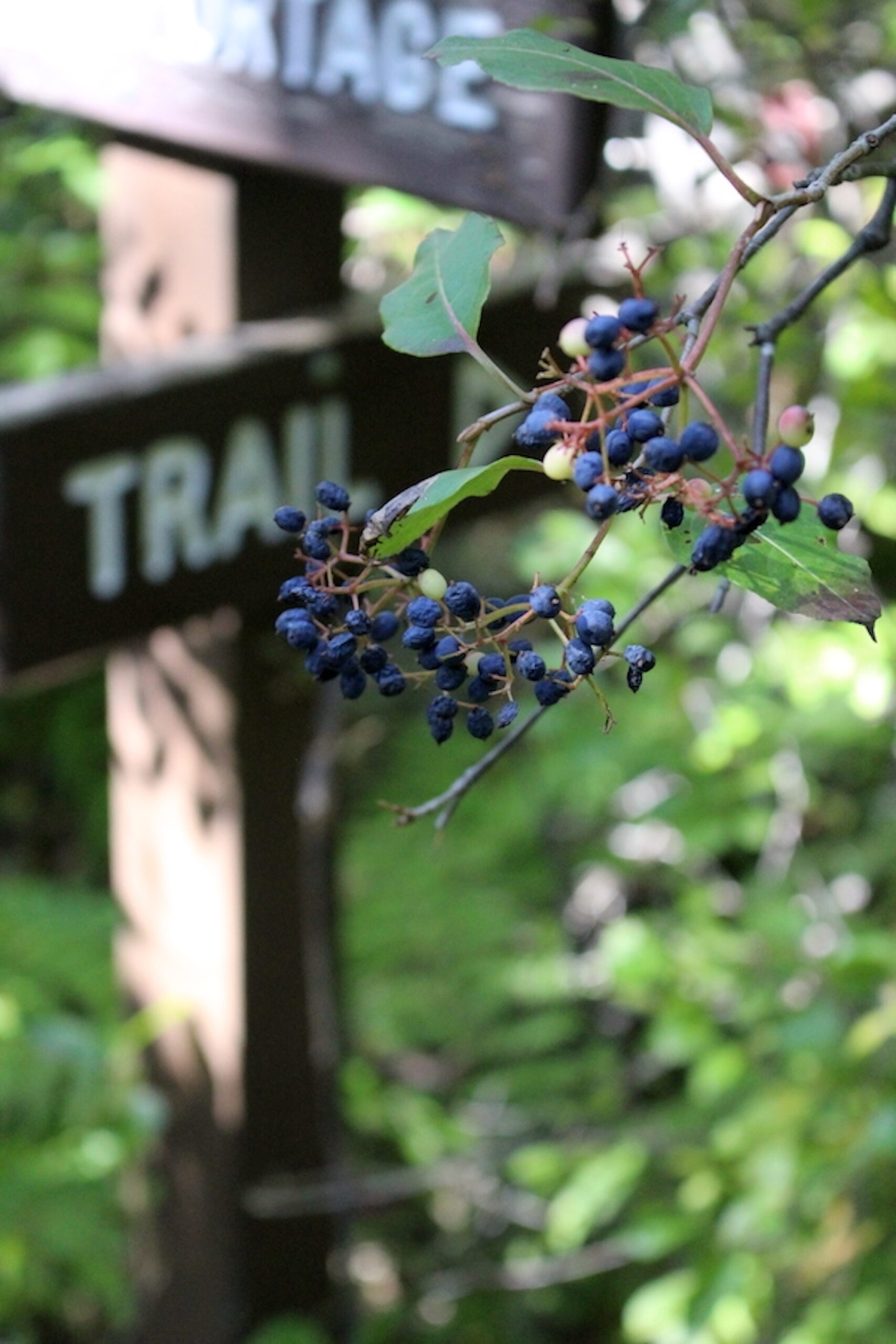
What is Witherod?
Witherod, also known as wild raisin, includes two species of perennial, deciduous shrub, southern wild raisin (Viburnum nudum) and northern wild raisin (Viburnum cassinoides). They are part of the Adoxaceae or Moschatel family.
Southern wild raisin is also called possumhaw, smooth witherod, or possumhaw viburnum. Northern wild raisin is also called raisinberry, blue haw, swamp haw, withe-rod, or witherod viburnum.
Both species are native to the eastern United States. Southern wild raisin’s range is predominantly in the southeastern United States, though it is found in coastal states north to Connecticut. Northern wild raisin grows from Newfoundland south to Georgia.

Is Witherod Edible?
Witherod produces tasty berries that are edible, raw, or cooked. Herbalists use the leaves, bark, and roots medicinally. The shrubs are considered quite safe for humans and animals alike.
However, large quantities of the berries may cause digestive issues.
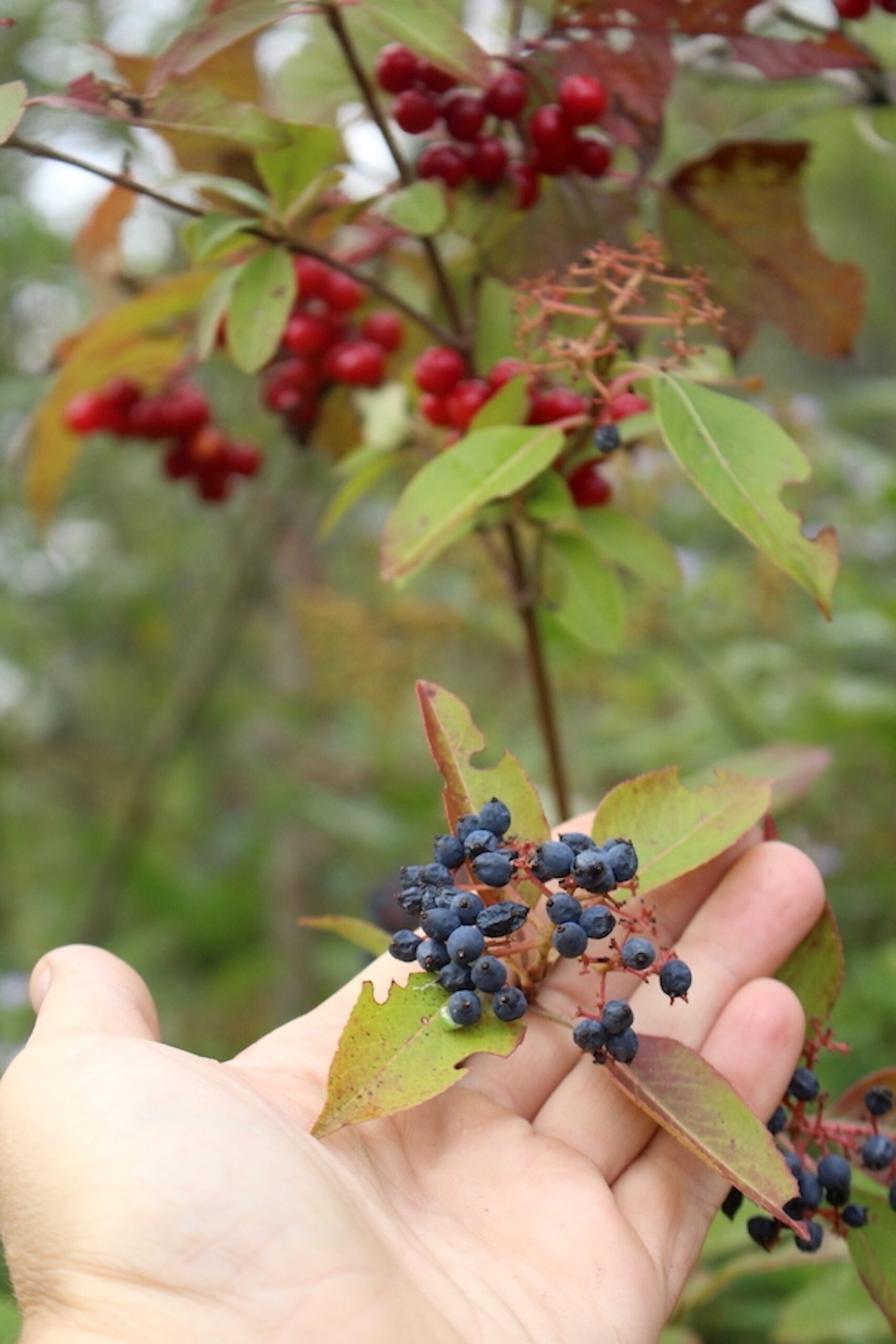
Witherod Medicinal Benefits
Historically, Native Americans used witherod medicinally. Reportedly, the Cherokee used the root bark in an infusion as a tonic, as a wash for a sore tongue, to induce sweating, to prevent recurring spasms, and to treat malaria, fever, and smallpox. Undoubtedly, other groups had uses for it, too.
Today, witherod has largely fallen from common usage, but some studies have indicated that it may have some important benefits. One 2016 study found that witherod had some inhibitory effects on Trypanosoma brucei, a parasitic kinetoplastid that causes Human African trypanosomiasis (sleeping sickness).
Unfortunately, few other modern studies are looking into witherod. However, the Viburnum genus has been the focus of many studies. Many Viburnum species have exhibited antioxidant, antibacterial, anti-inflammatory, cytotoxic, and anticancer activities.
Hopefully, these incredible species will be the focus of scientific studies in the future.
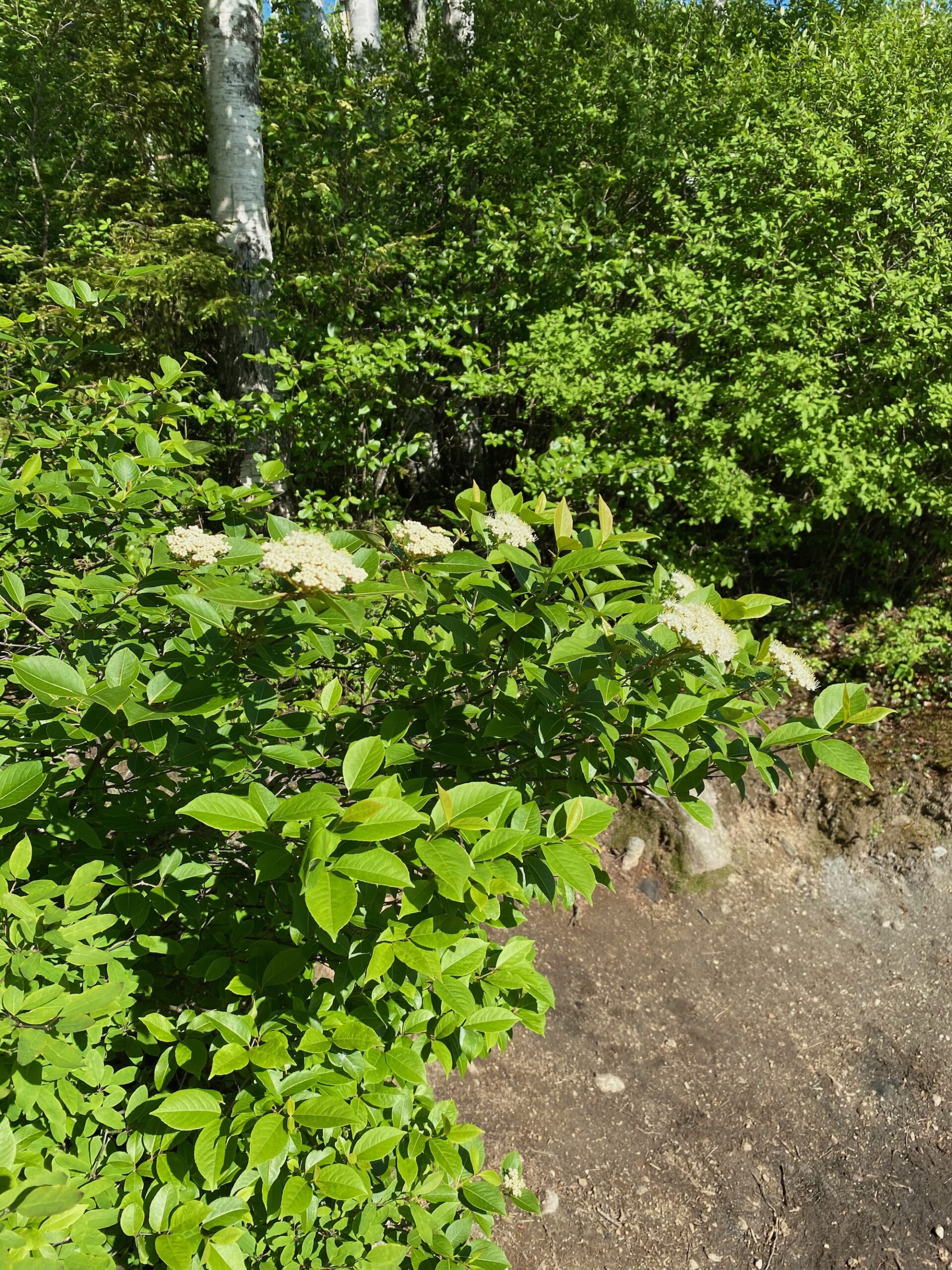
Where to Find Witherod
You can find witherod growing in the eastern United States and Canada. Northern wild raisin (Viburnum cassinoides) grows from Newfoundland south to Georgia. It is typically limited to cooler, mountainous areas in the southern parts of its range. Southern wild raisin (Viburnum nudum) is most common in the southeast but also grows in coastal regions north to Connecticut.
Both witherod species thrive in moist soil and full sun to partial shade, though northern wild raisin (Viburnum cassinoides) can adapt to drier sites once established. Southern wild raisin (Viburnum nudum) prefers acidic soil.
You’ll often spot northern wild raisins growing in bogs, along streams and rivers, and in moist, high-elevation forests and outcrops. Southern wild raisin likes similar but warmer habitats like low-elevation wet woodlands, savannas, bogs, and streambanks.
I often find wild raisins growing near the edges of ponds and wetlands, and it’s usually alongside Highbush Cranberry, another edible viburnum.
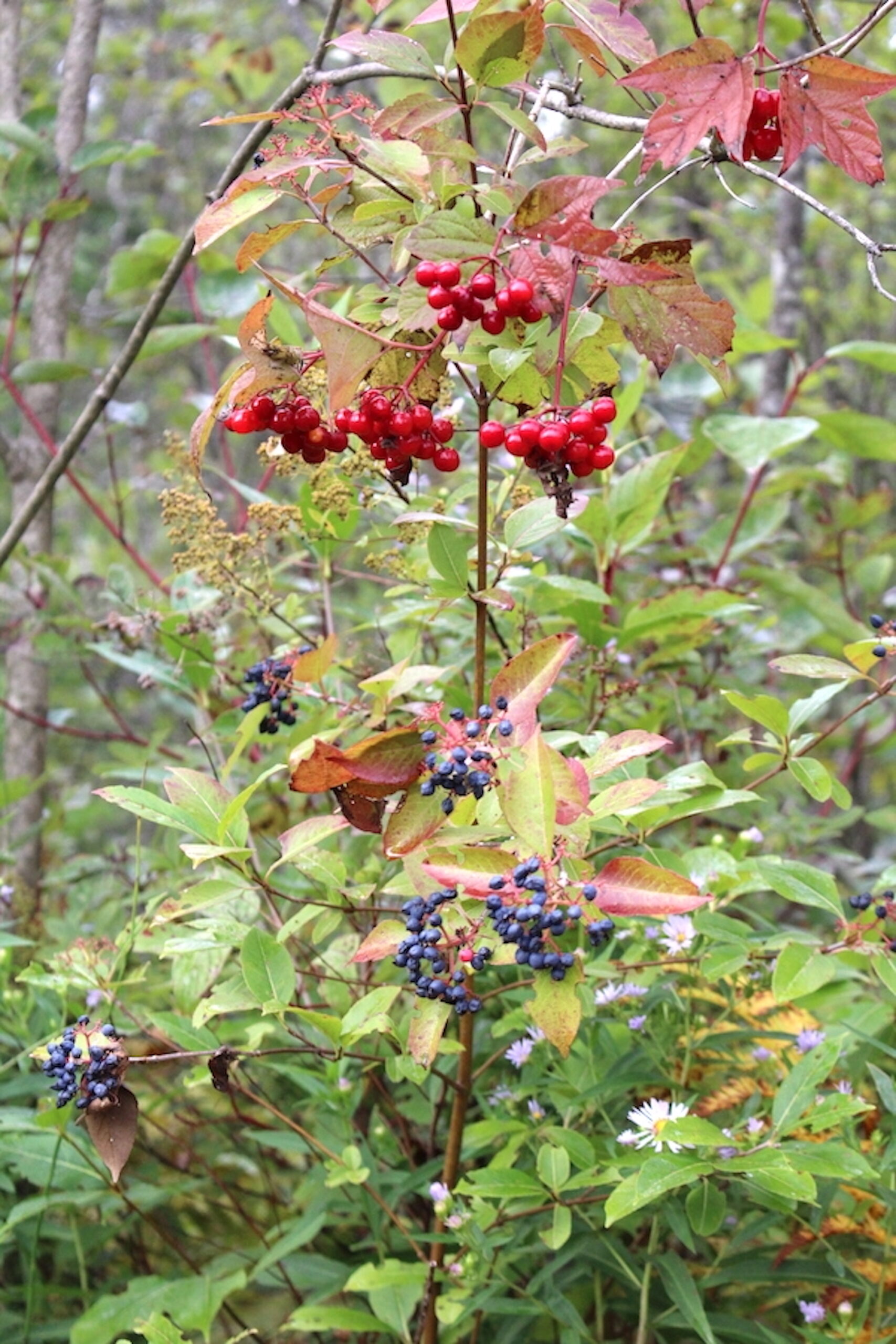
When to Find Witherod
Witherod is a deciduous perennial that loses its leaves each fall. Each spring, its leaves return and are followed by flowers. Southern wild raisin (Viburnum nudum) usually flowers between April and May. Northern wild raisin (Viburnum cassinoides) flowers in May or June.
You can harvest the leaves for medicinal purposes anytime in the summer, but if you want berries, you’ll need to wait for later summer or early fall. The berries of both species ripen between August and October, though berries usually ripen first in warm, southern regions. The berries often persist into the winter.
Wait to harvest the berries until they’re dark blue, purplish, or almost black and wrinkled. They should look a bit like raisins when they’re ready for harvesting.
Identifying Witherod
Witherods are loose, attractive, deciduous shrubs. Their showy, flat-topped clusters of white flowers in spring and early summer can help you identify them. Their berries also help set them apart, ripening from pink to dark blue or purple in late summer or fall and remaining into winter.
Witherod Leaves
Southern wild raisin (Viburnum nudum) has simple, glossy, dark green leaves 3 to 6 inches long. The leaves are oppositely arranged and elliptical or oblong.
Northern wild raisin (Viburnum cassinoides) has simple, dull, dark green leaves 1 to 3.5 inches long. The leaves are oppositely arranged and elliptical or ovate with irregularly toothed margins. New leaves are often tinged with bronze or purple.
In autumn, witherod puts on a show with colorful red, orange-red, reddish-purple, or purple foliage.
Witherod Stems
Southern wild raisins (Viburnum nudum) often reach 5 to 12 feet tall and wide with a rounded or spreading form. They have woody stems with smooth gray-brown bark with a few warty lenticels. The young twigs are slender, reddish-brown or copper with scruffy pinkish-brown buds.
Northern wild raisins (Viburnum cassinoides) often reach 5 to 10 feet tall and 5 to 8 feet wide. They are usually multi-stemmed and have a dense, round, or arching growth habit. They have woody stems with smooth gray-brown bark with many lenticels or wart-like pores. The twigs are brown and rough.
Witherod Flowers
Both witherod species produce showy, creamy, white clusters of flat-topped flower clusters 2 to 5 inches wide. The individual flowers are tiny, less than ¼ inch wide, and have 4 to 5 petals.
Southern wild raisin (Viburnum nudum) flowers between April and May, while northern wild raisin (Viburnum cassinoides) flowers between May and June.
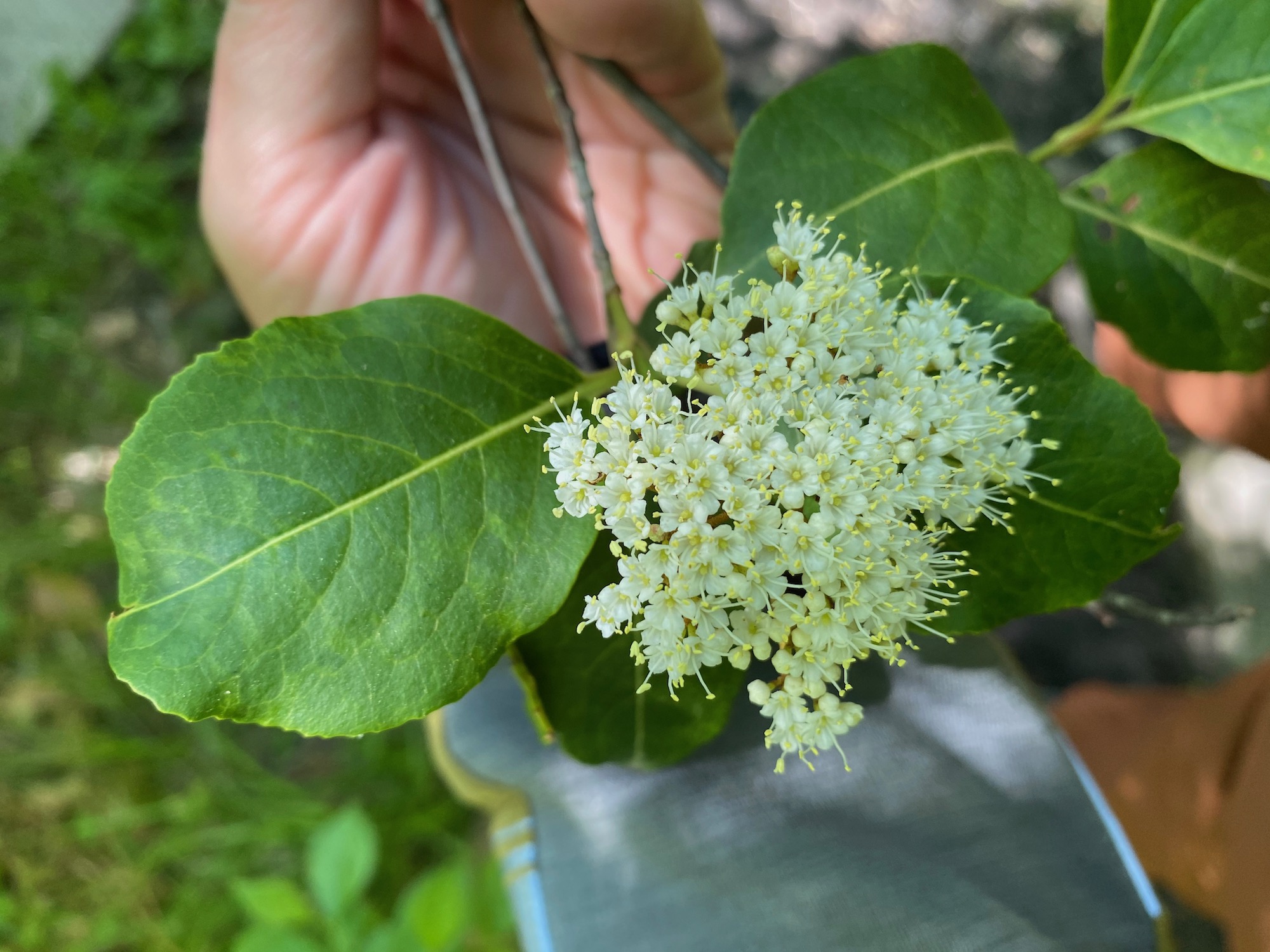
Witherod Fruit & Seeds
Both witherod species produce clusters of small edible fruits less than ⅓ inch long. The fruits are oval with noticeable bud ends. Each contains a single large seed. They usually ripen between August and October.
The fruits ripen from light green to light pink, then deep pink before finally turning blue to purplish-black. It’s common to find different colored fruit on the same cluster. The stems that hold the fruit are bright red.
The fruits tend to remain on the tree into winter and naturally dry and wrinkle, giving the plant its name ‘wild raisin.’
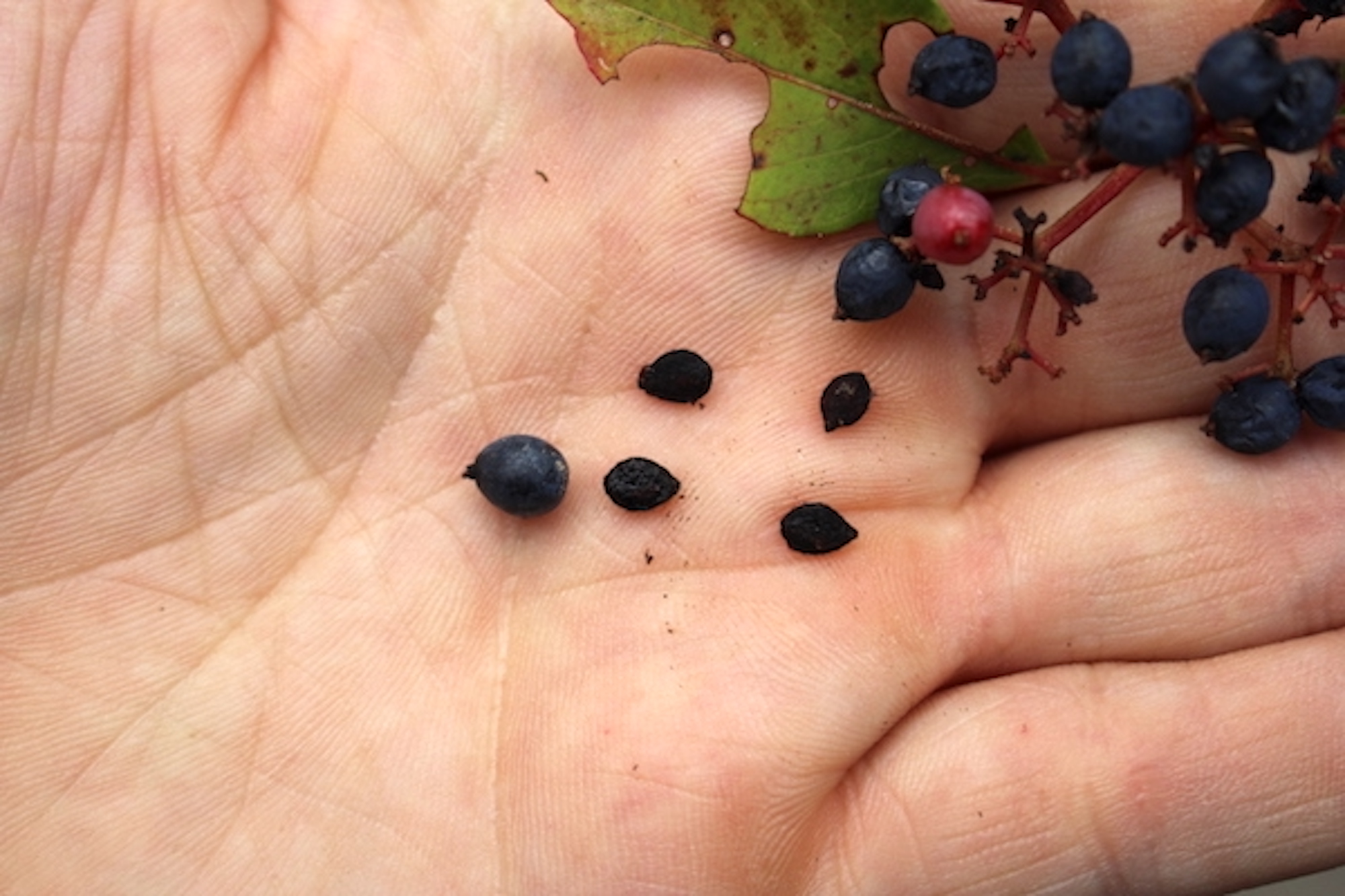
Witherod Look-Alikes
Wild Raisin may be mistaken for a similar, related species, Nannyberry (Viburnum lentago). However, Nannyberry can be easily distinguished in the following ways:
- Nannyberry is usually larger up to 18 feet tall.
- Nannyberry’s older bark becomes dark gray and deeply checkered with furrows.
- Nannyberry leaves are lance-shaped to elliptic and 2 to 4 inches long.
- Nannyberry fruits are usually larger, ⅓ to ½ inch long.
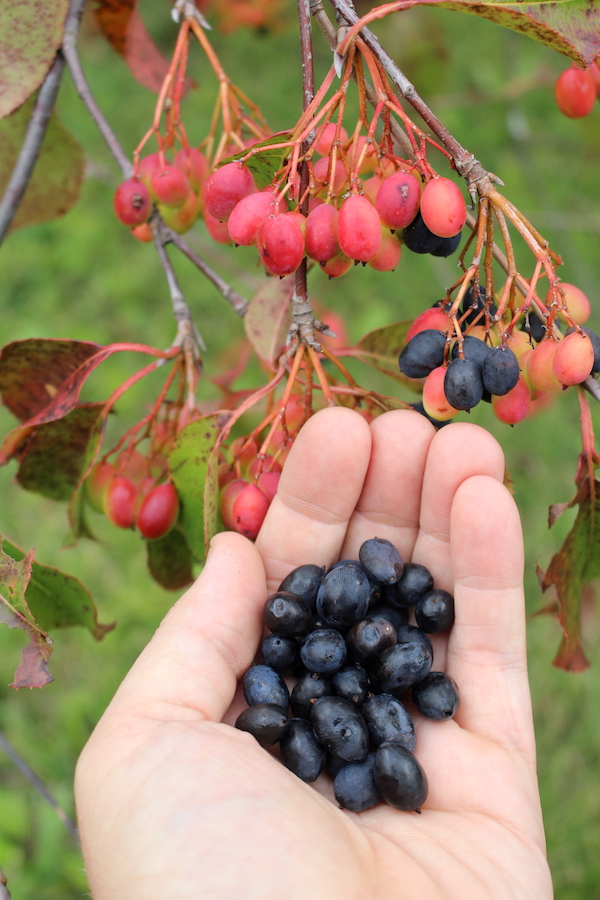
Witherod may also be confused with another choice edible, American Black Elderberry (Sambucus canadensis). However, the two differ in the following ways:
- American Black Elderberry has pinnately compound leaves up to 12 inches long.
- American Black Elderberry leaves have 4 to 10 paired leaflets and 1 terminal leaflet.
- American Black Elderberry has rounded fruits.
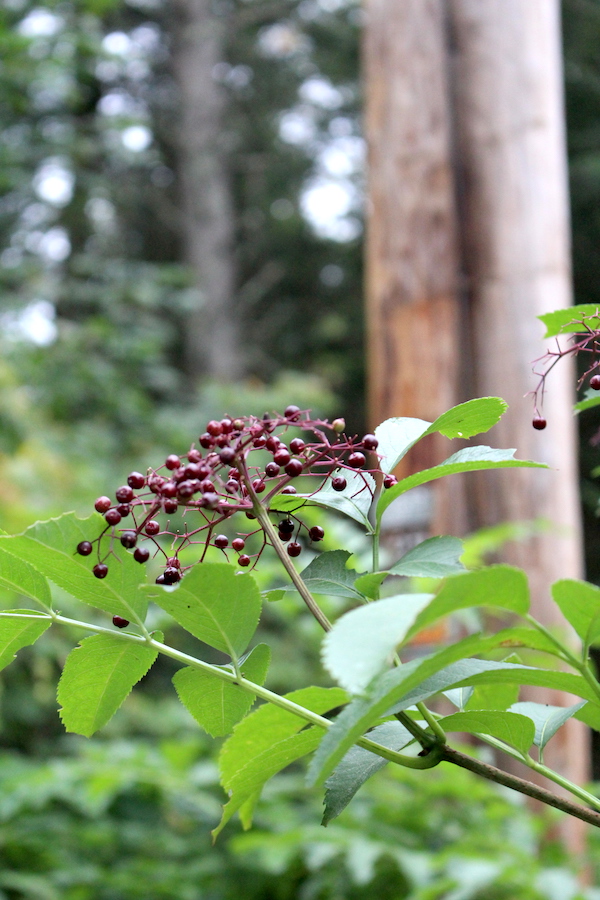
Witherod could also be confused with the poisonous American pokeweed (Phytolacca americana). Thankfully, Pokeweed differs in a few noticeable ways:
- Pokeweed has weak, often pinkish-red, partially hollow stems.
- Pokeweed has thin alternate leaves 7 3/4 to 14 3/4 inches long.
- Pokeweed flowers are whiteish, greenish, occasionally pinkish or purplish, and form linear clusters.
- Pokeweed berries form on the same linear stems.
- Pokeweed berries are round.
Ways to Use Witherod
Wait to harvest your witherod berries or wild raisins until they’re fully ripe, dark-colored, and wrinkly. They’ll be pleasant and sweet at this stage, much like a date or raisin.
One of the best parts of wild raisins is their shelf life. They will last for several days at room temperature or for several weeks in the fridge. You can also freeze wild raisins for extended storage.
You can eat the seeds, but most people like to remove them. Cooking wild raisins down with a bit of water and running the puree through a food mill to remove the seeds is a good choice. The resulting wild raisin fruit butter will come out thick and sweet. You can use it to spread on toast, crackers, or enjoy it plain like a pudding.
You can also use your wild raisin puree in various other dishes. Try adding your wild raisin butter to muffins, quickbreads, fruit leathers, ice cream, or other sweet treats.
Wild raisins may also make tasty additions to fermented beverages like mead or cider. If you’re not up for fermenting, you could also use them to flavor a homemade liqueur.
Wild raisin leaves make a pleasant-tasting tea substitute and may also have some medicinal value. You can experiment with making infusions and tinctures from wild raisin leaves, bark, and roots.
Wild Raisin Recipes
- This Maple Nannyberry Butter Puree recipe from the Forager Chef is for the closely related Nannyberry (Viburnum lentago), but it will work for wild raisins, too.
- Similarly, this recipe for Haw Wine from Wild Food by Roger Phillips may be easily adapted to wild raisins.
Fruit Foraging Guides
Looking for more tasty edible wild fruit?
- Foraging Bunchberries
- Foraging Saskatoons (Serviceberries)
- Foraging Wild Black Cherries
- Foraging Chokecherries
- Foraging Aronia (Black Chokeberry)
- Foraging Barberry
- Foraging Rose Hips
- Foraging Rowanberry
- Foraging Autumn Olive
- Foraging Partridgeberry
